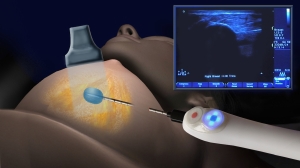Cryoablation is a novel treatment currently used to treat benign breast tumors (called fibroadenomas). Cryoablation is now being studied in patients with certain types of small breast cancer. The treatment places a small probe in the center of the cancer and subsequently uses liquid nitrogen to destroy breast cancer tumors by freezing them.
In the treatment of fibroadenomas, cryoablation has proven less invasive and less likely to affect cosmetic appearance than surgery. It could be possible for breast cancer patients to enjoy the same benefits in the future.
“Cryoablation of Low Risk Small Breast Cancer- Ice3 Trial”
Breastlink Laguna Hills, through our partnership with the Cancer Research Collaboration, recently became a research site in the “Cryoablation of Low Risk Small Breast Cancer- Ice3 Trial.” This research study, identified by the U.S. National Institutes Health as NCT02200705, is sponsored by IceCure Medical Ltd. It is important to note that joining a research study is an important personal decision. Not all patients will meet the strict criteria of this study. Please contact our office if you would like to be in touch with a member of the Cancer Research Collaboration research team.
How does cryoablation work?
The American Society of Breast Surgeons calls cryoablation of fibroadenoma ‘safe, efficacious and durable.’ Currently, the American Society of Breast Surgeons only recommends cryoablation for patients with fibroadonemas diagnosed by biopsy. During the procedure, ultrasound is used to produce images of internal breast tissue and to guide a probe to the exact location.
- Local anesthesia is applied prior to the procedure to limit any potential discomfort or pain.
- The probe resembles a thin needle and is placed in the center of the tumor fibroadenoma.
- During the treatment, liquid nitrogen is passed into the probe creating extremely cold temperatures that destroy the targeted breast tumor within the freezing zone of the probe
- The procedure generally lasts 15 minutes or less.
- Over time, the body’s normal healing processes resorb the tumor cells frozen by the cryoablation eliminating the tumor from the breast.
Fibroadenomas are noncancerous or benign breast tumors. They generally do not increase risk for breast cancer or cause complications. They can however cause discomfort, which leads some women to have them treated.
For these women, cryoablation is an alternative option to surgery. Surgery is more costly, more invasive, more likely to affect cosmetic appearance and requires more time to recover from.
Could cryoablation be used to treat breast cancer tumors?
Early research has produced promising results for the use of cryoablation as treatment for certain types of breast cancer tumors. In 2014, the American College of Surgeons Oncology Group (ACOSOG) announced that cryoablation showed potential as an alternative to surgery for selected women with early-stage invasive ductal breast cancer (IDC).
In a phase II trial exploring cryoablation therapy in the treatment of Invasive Ductal Carcinoma, researchers declared that all breast cancer tumors less than 1 centimeter in diameter treated with cryoablation had no residual cancer after treatment. The success rate for cancers of any size was approximately 80 percent.
“With cryoablation, a woman need not enter the operating room for treatment, and the procedure can be as brief as 20 minutes,” said Rache Simmons, M.D., chief of breast surgery at New York Presbyterian/ Weill Cornell Medical Center, in a statement issued by the American Society of Breast Surgeons. “Compared to surgery, cryoablation is an effective non-surgical treatment for breast cancer in certain early stage patients.”
While early results of research investigating cryoablation for the treatment of IDC are promising, it will take time for this to become standard care. However, we are excited to be part of emerging technologies for breast cancer tumor treatment and to offer cryoablation of fibroadenomas at Breastlink Laguna Hills.
Hopefully, this procedure proves to be a useful technology in breast cancer treatment that can help select patients avoid the risks associated with surgery and treat their cancer in a less invasive fashion.




Add new comment